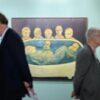Editor’s Note: This story originally appeared in On Balance, the ARTnews newsletter about the art market and beyond. Sign up here to receive it every Wednesday.
It is tempting, at the end of the year, to look back and try to draw some grand conclusion about the events, large and small, that appear to have moved the art market one way or another over the last 12 months. December is as good a time as any for reflection, but it’s important to consider the past as part of a continuum, in the art world as everywhere else. Barring a cataclysmic event—knock on wood—people will very likely always be buying art. The end is not nigh and the market advances. Where you draw the line, as journalist, collector, dealer, or auction house bigwig, will determine your perspective.
That said, this year was not without memorable events: 2024 was peppered with lawsuits, auction records, and disappointing performances, more than a few gallery closings, and a lot of hot air forecasting that the art market was near the end. The art market, perhaps even more than, say, the stock market, is a fragile mechanism, often more affected by perception and sentiment than by clear fundamentals. It’s a bit of a reversal of Chicken Little: The more one proclaims the sky is falling, the faster it falls, at least for a little while.
It certainly seemed like the sky was falling over at Sotheby’s this year. While the auction house came out clean in its legal battle with Russian oligarch Dmitry Rybolovlev in February, the proceeding illuminated much of its shadowy private sales process. Still, it may have been the high point for the company. Just a few days later, Sotheby’s introduced a new, more standardized fee structure that it said would bring greater transparency to the market. It was a bold move that favored buyers over sellers. One market expert told me at the time that the restructure was Sotheby’s way of saying “this is what we are worth.” Fortune does not always favor the bold, however: Last week, with the new policy in place only since May, Sotheby’s reversed course. The subtext of CEO Charles Stewart’s interview with the Art Newspaper last week: No one liked the change, especially not sellers, who were not enticed to alleviate the market’s “supply issues.”
“We need to be responsive. We’ve tried, we’ve learnt and we’ve listened,” Stewart said.
Those supply issues led to a disappointing year for the two major auction houses. While Sotheby’s has yet to release its 2024 earnings, a spokesperson told ARTnewsthat it totaled approximately $6 billion, a roughly 25 percent drop from the $7.9 billion it reported in 2023. Christie’s fared only marginally better, announcing earlier this month that it had totaled $5.7 billion for 2024, an 8 percent drop from last year’s $6.2 billion total.
Still, the year was far from a fiasco. Collectors in both the May and November evening sales may have exercised prudence, but they went all in when the right material hit the block. Christie’s sold the year’s top auction lot, René Magritte’s Empire des lumières (1954), at the 20th-century evening sale in November; realizing $121.1 million, it was the only work this year to pass the exalted $100 million mark. Bravo.
That’s a stark change from the last two years, when the houses’ totals were juiced by the $1.5 billion Paul Allen sale at Christie’s (2022) and the $406 million Emily Fisher Landau sale at Sotheby’s (2023). While those sales came amid the frothy market induced by Covid and low interest rates, they were also heavy in top-tier material that this year sadly lacked. As interest rates—and political and geopolitical uncertainty the world over—remained high throughout 2024, it’s perhaps not surprising that collectors decided to hold on to the best works in hopes of greater profit later.
But what Sotheby’s lacked in sales, it made up for in ink. This year, the house closed a deal with Abu Dhabi’s ADQ sovereign wealth fund for the investment of nearly $1 billion (promptly used to retire debt), bought the storied Breuer Building, and laid off at least 150 staffers across the company. Notable sales included a really lovely Monet and a very expensive banana, the latter immediately eaten by a man holding a microphone with a picture of a banana on it. The Marx Brothers would have loved it. Karl Marx, less so.
Despite the shortage of collectors willing to sell, plenty of collectors were happy to buy. They just weren’t buying at the top of the market, according to Clare McAndrew’s Art Basel and UBS Survey of Global Collecting, published in late October. McAndrew found that, while spending was down by 32 percent, total volume of sales was actually up.
The often-unheeded day sales proved to be the twist in the martini both for the houses and the more clever collectors, who found value and promise in overlooked Modernist and postwar artists: Lynne Drexler, Lois Dodd, and Gertrude Abercrombie all achieved new auction records this year. Art adviser Lindsay Jarvis told me that artists like Dodd and Drexler fit the profile of the types of artists collectors should be looking to buy right now. “They provide buyers with long term investment opportunities where there’s a compelling argument that the artists’ bodies of work should be reevaluated and integrated into the art historical canon,” he said.
According to former Sotheby’s rainmaker Gabriela Palmieri, one reason the auction houses suffered was a lack of true believers. “This year the market was full of agnostics,” Palmieri told me. “The spring sales had nothing good enough to motivate collectors. But in the fall, the truth is that the auction houses under-promised and over-delivered. On a case-by-case basis, when the works were good, collectors and connoisseurs took notice. And often those works were still a bargain.”
The auction houses weren’t the only market sector to see change. Art fairs continue to grow both in size and frequency, but this year, that growth had an interesting outcome: The mega-fairs Art Basel and Frieze seemed to become less global and more regional. Frieze Los Angeles and Art Basel Miami Beach were hot spots for US and South American artists and collectors, while Frieze London and Art Basel Paris were the focus for European and African art. Art Basel Hong Kong, Art SG in Singapore, and Tokyo Gendai drew artists and collectors from the region. While no fair is a monolith, this year’s challenging market and packed calendar compelled galleries to make judicious choices regarding participation.
The year’s most global fair, perhaps surprisingly, was Art Basel Paris, in its third edition. Among the possible reasons: Paris in October (lovely), the grand opening of the newly renovated Grand Palais, a waning of importance for Frieze London. While art dealers always tend to characterize a fair by “strong sales” and “lively crowds,” business at Art Basel Paris really did thrum by all accounts. And, in a market as fickle as art, that was perhaps enough to shift sentiments to positive.
“Over the course of 2024 we saw dire pessimism give way to cautious optimism,” Alex Glauber, president of the Association of Professional Art Advisors, told me. “The pervasive negativity across the market over the last year tempered appetite amongst collectors, and any sense of urgency. The good news is that there is a consensus that we’ve found the ‘floor’ of the current environment.”
While the November auction totals were far off those of a few years ago, market watchers like Glauber have pointed to a depth of bidding this season that suggests a market rebound is on the horizon. With Art Basel Miami Beach performing admirably, continuing wealth growth for the ultra-rich, and a Federal Reserve further cutting interest rates, it’s not hard to see the art market experiencing a recovery in 2025.
Perhaps then, 2024 can be summarized as a return to, and acceptance of, reality. The market is not always going to boom. But there will be movement. A scene in which speculators were ever eager to drive up prices and inestimable estates came to auction every season now features collectors sifting through evening and day sales for undervalued gems they believe they can live with for a while. Collectors actually collecting. So it was, and so it shall be.
This post was originally published on this site be sure to check out more of their content








